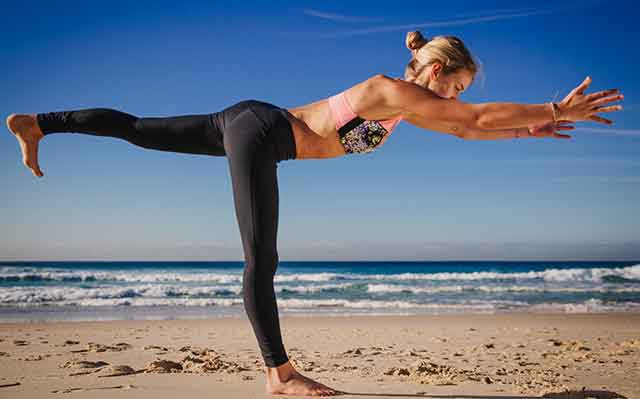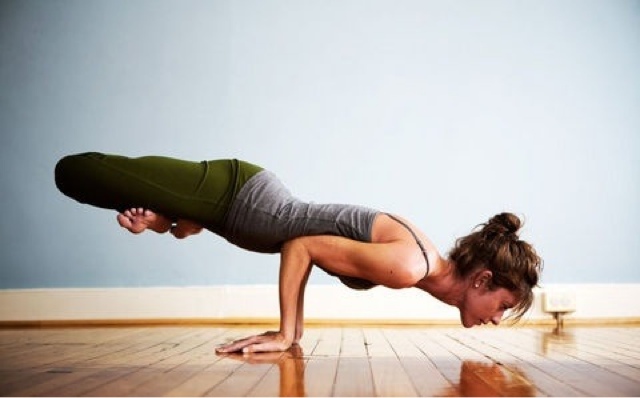Benefits of Yoga
All possible benefits of Yoga
More flexible, more powerful, quieter … Can you get to all benefits that yoga provides? We bring you a summary of benefits from the Yoga article of doctor Timothy McCall who in 2002 traveled to India in search of yoga practitioners.
You’ll often hear that in yoga hardest thing to decide is to exercise. Check out all the befits of yoga and get true inspiration!
Flexibility
More flexible body is one of the first and obvious welfares of yoga. In the first hour of yoga probably will not be able to touch your toes, not to mention the crease backwards. But if you persevere, you will notice that the exercise becomes easier, and eventually you will find yourself in a seemingly unreachable places. It will be quite straining and pain. This is no accident. For example, rigid quadriceps disrupt the proper relationship thigh and calf and thus burden the knees. Solid hamstrings can flatten the lumbar spine leading to back pain. A rigid muscles and connective tissues, such as fascia and ligaments, can ruin posture.
Strength
Strong muscles are not only beautiful. They keep us from arthritis and back pain. Older people with greater muscle mass less risk of falls. Empower you body yoga, also will be springy. If you were instead to go to the gym and pumping weights, likely to become more powerful at the expense of flexibility.
Correct posture
Head is like a bowling ball – big, round and heavy. If it is above the upright spine, neck and back muscles it easy posture. Tilt your head a few inches forward and forcing the muscles to work overtime. Who would not be tired of giving such a ball eight or even twelve hours a day? Fatigue might not be the only problem. Poor posture can affect the muscles and joints, back, neck and shoulders. If you’re constantly hunched over, your body will flatten or natural curvature of the neck and lower back, which in turn can cause pain and degenerative arthritis of the spine.
Mobile joints
Each time you practice yoga, the joints through the entire range of motion. So you can prevent degenerative arthritis or alleviate pain (es) balance tilting and “squeezing” or inactive areas of cartilage. Articular cartilage is like a sponge; nutrients only receives fluid change – press out the old to bring new nutrients. Without proper feeding, neglected parts of the cartilage frays like the old brake and open the way to the bone, which are protected.
Vital spine
Spinal disks – shock absorbers between the vertebrae that can be prodručiti and compress nerves – cry for the movement. Only in this way come to nutrients. If you practice a balanced, meaning with enough folds back, forward and twisting of the spine, you will help your discs to remain mobile.
Strong bones
Numerous studies had shown that weight lifting strengthens bones and prevents osteoporosis. In many yoga positions we raise our own weight. The position of a raised dog, for example, strengthens the bones of the hands that are particularly vulnerable to osteoporotic fractures. In an unpublished study University of California, Los Angeles, yoga is the increased density of the vertebrae. Yoga also reduces levels of the stress hormone cortisol (see 11), and thus helps the bones to retain calcium.
Better circulation
Yoga revives the bloodstream. Specifically, yogic relaxation exercises will stimulate your circulation, especially in the hands and feet. The cells get more oxygen. Venous blood due to torsion leaves the internal organs, and when we get out of the situation in organs gushing blood is full of oxygen. Inversions, such as standing on their heads, arms and shoulders drain and the blood from the legs and pelvis to the heart, and further to the lungs, where it takes in fresh oxygen. • Does your legs due to problems with the heart and kidneys, these positions or their adjustments could help. Yoga also increases the level of hemoglobin and red blood cells that deliver oxygen to tissues. Platelets become less adhesive, while the number of proteins involved in the formation of blood clots reduces. It is less likely to befall us heart attacks and stroke.
Enhanced immunity
Any time you tighten or stretched muscle, pushing the authorities to enter or exit the yoga position, improve lymph drainage (a viscous fluid rich in cells of the immune system). The lymph system is then better fight off infections, destroys cancer cells and flushes toxic cellular waste.
A happier heart
Whether an often heart in the aerobic zone, you reduce the likelihood of heart attack and vulnerability to depression. Although all styles of yoga are not aerobic exercise you stronger or system ashtanga vinyasa yoga, you can be in an aerobic zone. Even exercises that do not speed up your heart can strengthen the cardiovascular system. Research shows that practicing yoga slows the heart rate at rest, increases endurance, and that can increase maximal oxygen uptake during exercise. All these are also the consequences of improved aerobic fitness. In one study, people who have learned pranayama were able to exercise more, while spending less oxygen.
Lower blood pressure
Do you have high blood pressure, yoga would be unable to put down. Two studies compared the order to hypertensive people affected yogic position of deep relaxation and usually lying on the couch. After three months, yogic position lowered systolic blood pressure (the top number) by 26, and diastolic (bottom number) of 15. What is the pressure was higher, there was a greater fall.
Less Stress
Yoga lowers cortisol. If you just thought – “So what?” – Keep reading. The adrenal glands secrete cortisol in extremely stressful situations, which temporarily boosts the immune system. If he stays elevated cortisol and after crisis situations, can weaken the immune system. Brief increase cortisol helps long-term memory, but chronically high levels impair memory and can lead to permanent changes in the brain. In addition, excessive levels of cortisol are associated with major depression, osteoporosis (extracts calcium and other minerals from bones and interferes with the recovery of the bone), high blood pressure and insulin resistance. High cortisol forcing rats to over eat when they are anxious, angry or tense. The body then converts excess calories into abdominal fat, it becomes harder and more prone to diabetes and heart attack.
Natural happiness
You are being sad? Sit in the lotus position. Or better yet, the royal soar in the crease backwards. Although not quite as simple to get rid of depression, one study found that regular yoga practice facilitates depression, significantly raises serotonin levels and reduces levels of monoamine oxidase (an enzyme that breaks down neurotransmitters) and cortisol. Doctor Richard Davidson found that the left prefrontal cortex in meditators work harder, resulting in a happier mood and a stronger immune system. The estimated activation of the left prefrontal cortex is characteristic of serious, long-term meditators.
Better figure
More on the 13th move, eat less – will tell all dieters. Yoga can help with one and other. Regular exercise activates the body and burn calories while you spiritual and emotional dimensions of exercise can be encouraged to contemplate the problem of eating at a deeper level. Yoga you can also learn to eat consciously.
Goodbye sugar and cholesterol!
Yoga lowers blood sugar and LDL (“bad”) cholesterol and increases HDL (“good”) cholesterol. People affected by diabetes, yoga lowers blood sugar in several ways: lowering levels of cortisol and epinephrine, helps with weight loss and enhances the effects of insulin. If you reduce blood sugar, reduce’re likely to have complications that accompany diabetes: heart attack, kidney failure and blindness.
Trained brain
An important part of yoga is to stay in the present. Research shows that regular yoga practice improves coordination, reaction time, memory, and even the number of points on IQ tests. Meditators TM easier to solve problems faster recall, probably because they interfere less casual thoughts that closed loop can spin indefinitely.
Thicker nerves
Yoga helps you relax, concentrate on the present and slow down your breathing. That activates the parasympathetic nervous system and soothes the sympathetic (“fight or flight”). Parasympathetic system calms and relaxes, slows breathing and heart rate, lowers blood pressure and increases blood flow to the intestines and sexual organs. Doctor Herbert Benson all calls reacting relaxation.
Finding your way
Regular yoga practice improves proprioception (awareness of the activities of the body and its position in space) and a sense of balance. People with bad posture or dysfunctional movement patterns usually have poor proprioception, which is associated with a problematic knee and back pain. A better sense of balance could mean fewer falls. For seniors it means more independence and later (if at all!)
I’m my own boss
Some advanced yogis can manage their bodies to the extraordinary ways, many of which are associated with the nervous system. Investigators yogis who could manage heartbeat, specific brain frequencies and raise the temperature of the palms of 8 degrees Celsius. Can they all that, maybe you can learn how to improve the flow of blood to the pelvis trying to get pregnant or how to relax when you grab insomnia.
Break of chronic fatigue
Catch you ever to crush the iron grip the phone or the steering wheel or frown face while watching the monitor? These unconscious habits result in chronic tension, muscle fatigue and pain in the wrists, arms, shoulders, neck and face, which in turn increases stress and worsens mood. Practicing yoga begin to notice where tension builds up – perhaps in language, eyes, or the muscles of the neck and face. Learn how you just pay attention, you’ll be able to release the tension from the eyes and tongue. To consciously relax bigger muscles such as the quadriceps, trapezius and gluteus You may need several years.
Paradise for nerves
Stimulation is preferred, but too much stimulation will burden your nervous system. Yoga can become a haven of refuge in the stir of modern life. Rejuvenating postures, yoga nidra (a kind of guided relaxation), the position of deep relaxation and meditation all help turning the senses inwards which provides much-needed vacation nervous system. Another side benefit of regular exercise yoga is better sleep which means you’ll be less tired and stressed.
Through meditation to health
“Asana” and “Pranayama” probably raise immunity, but so far the best-documented effect of meditation in this area. It appears to have a beneficial effect on the functioning of the immune system, enhancing it (for example, the rising level of antibodies after immunization) or calming (mitigates undesirable aggressive behavior of the immune system in autoimmune diseases such as psoriasis).
Full forward
Yogis breathe less and fuller lungs, soothes and is more efficient. In one study of 1998 people who were gasping for congestive heart failure were taught yogic breathing technique complete. After one month, the average Write speed their breathing dropped from 13.4 breaths per minute to 7.6. They started better physical exercise, blood in more oxygen. In addition, yoga is proven to enhance the various functions of the lungs, including the maximum volume of inhalation and exhalation efficiency. Yoga also helps to breathe on his nose, which filters the air, warms it (cold and dry air can cause asthmatic attacks in susceptible people) and moisturizes and removes pollen, dirt and other things that should not want in your lungs.
Anti-stress
Ulcers, irritable bowel syndrome, constipation – all of them stress worsens. So if you are less stressed, you will suffer less. Yoga, as well as any exercise can help with constipation – and thus theoretically reduce the risk of bowel cancer – because movement helps faster transport of food and waste through the intestines. Although it is not yet scientifically confirmed, yogis claim that bloat accelerate the excretion of waste products.
Peace of Mind
According to Patandjalie`s “yoga sutras”, yoga calms the modifications of the mind. Translate it, yoga unravels mental loops of frustration, neprežaljenih situation, anger, fear and desire that all leads to stress. And since stress is an integral part of many health problems – from migraines to insomnia and lupus, multiple sclerosis, eczema, high blood pressure and heart attacks – you learn to calm your mind, you’ll probably live longer and healthier.
The emotional and spiritual health
A lot of us suffer from a chronic lack of confidence. Access to this the negative – you drink tablets, overeat, work, or sleep too much – you will pay poorer physical, mental and spiritual health. If you approach a positive and practice yoga, you will feel, at first intermittently, all the more that the worth or, according to yogic philosophy that you are a manifestation of the divine. Are you exercising regularly, watching your thoughts and reactions with the intent to improve, you will open access to a different dimension of your being. You will experience gratitude, compassion and forgiveness, and the feeling that you are part of a larger whole. While better health is not the goal of spirituality, it is often a side effect, as shown by repeated scientific studies.
Help with pain
Yoga can reduce your pain. Several studies suggests that yogic postures, meditation or a combination reduces pain from arthritis, back pain, fibromyalgia, carpal tunnel syndrome and other chronic diseases. If you are less pain, you will be in a better mood, more active and you will need less medication.
New steadfastness
Yoga can bring changes in life. In fact, this is perhaps its greatest strength. Tapas, sanskrsta word for Jarah is a fire, a discipline that runs yoga and that regular exercise fueling. Tapas will help you burn inertia and change dysfunctional habits. Without special efforts will begin to eat healthier, exercise more or you finally quit smoking after years of unsuccessful attempts.
Orientation and Support
Good teachers of yoga can do wonders for your health. Exceptional teachers can take you only through the positions. They can adapt to the situation, to encourage you to explore it more deeply or loosen. Can you with compassion point out the flaws, help you relax and adapt exercise to suit your needs.
Less drugs
29th Do you have enough medication in the house for a small pharmacy, it may be time to try yoga. Research shows that yoga for people suffering from asthma, type 2 diabetes and obsessive-compulsive disorder has helped to reduce the dose of medication, and sometimes to completely stop taking them. Do you spend less medication, you’ll spend less money and possessions is the probability of side effects or adverse interactions between various drugs.
Anger Management
Yoga and meditation to develop awareness. And you’re aware, the easier it will get rid of destructive emotions like anger. Research suggests that chronic anger and hostility equally at risk for heart attacks as smoking, diabetes and high cholesterol. Yoga calms anger by increasing feelings of compassion and connection, as well as calming the nervous system and mind. It also helps to move away from their life’s drama and to keep the peace when it goes wrong. You can still react quickly if necessary – yoga is proven to reduce reaction time – but just before you choose and thoughtful response and not hurt himself or others.
Harmonious relations
Love maybe not winning everything, but it certainly helps to heal. Cultivating the emotional support of friends, family and community always shows good health. Regular yoga practice helps us to be more cooperative, compassionate and calm. Along with yogic philosophy that emphasizes nonviolence, truthfulness and modesty connection you can only become better.
Good vibrations
The basic elements of yoga – asana, pranayama and meditation – a positive effect on health, but that’s not all. Intonation syllable Om prolongs exhalation which balances the nervous system. A recent survey by the Swedish Karolinska Institute connects singing style Om opening and purification sinuses.
Imagine the change
Do you keep a particular image in mind, as in yoga nidra and similar exercises, you can start a change in the body. Several research indicates that guided visualization reduces postoperative pain, headache frequency and raises the quality of life of cancer patients and AIDS.
Cleaning the body
Krie, or exercises of cleaning, are another element of yoga. These include rapid breathing exercises from a thorough internal cleansing the bowel. Jala neti, mild rinsing the nasal passages with salt water from the nose removes pollen and viruses, prevents the accumulation of phlegm and sinus discharge.
Helping each other
Karma yoga (helping others) is an integral part of yogic philosophy. Even if you are not attracted to this idea, helping others is good for your health. Research University of Michigan found that older people who volunteer a little less than an hour a week threefold increase their chances to be alive after seven years. Do you help others, you might find meaning in life, and your own problems will be minor compared to those of others.
With Hope to Health
In conventional medicine, most of the patients in the passive role. The yogi is in turn the most important thing you do for yourself. Yoga gives you the tools to inspire change and most likely you will feel better after the first exercise. You will see that the more you focus on exercise, the greater the benefit. Once you start to take care of themselves in this way, you will discover that you work on it gives the power to change, and when you see the changes you will awaken in you the hope. And the very hope can heal.
Everything is connected
You’ve probably noticed a lot of overlap in ways that you do yoga improves health. This is because they are very intertwined. Change your posture and you change your breathing. Change your breathing and you will be changing the nervous system. This is one of the great lessons of yoga: it is all connected, Femur lower leg, you with the community, your community with the world. Understand the connection means to understand yoga. This holistic system simultaneously activates numerous mechanisms whose effects add up, and sometimes even multiply. This synergy may be the main way that yoga heals.
Placebo or not?
Do you believe that you will be better, it probably will. Unfortunately, many conventional scientists believe that the method that works by using a placebo was not noteworthy. However, most patients simply want to have to get better, so if intonation of the mantra – you might work at the beginning hour of yoga or meditation – helps healing, even if it is a placebo, why not try?




 Tweet
Tweet

